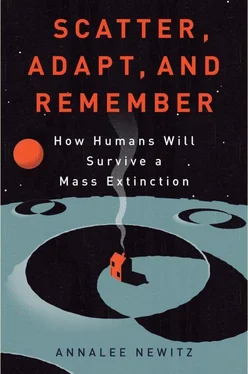How do you dodge an incoming piece of space junk that’s headed right to your elevator ribbon? Engineer Keith Lofstrom suggested mounting the ribbon on a massive maglev platform designed to move the line in any direction very rapidly, basically yanking it out of the way. Rice University materials-science researcher Vasilii Artyukhov argued that we might not want to use carbon nanotubes at all, because they break in several predictable ways, especially when they’re under constant strain and bombarded with cosmic rays from the sun. He thought an alternative material might be boron nitride nanotubes, though these are even more experimental than carbon nanotubes at this point.
Ultimately, the elevator cable is our stumbling block in terms of engineering. But there are also social and political issues we’ll have to confront as we begin our journey into space.
Kick-starting the Space Economy
Building the elevator goes beyond engineering challenges. First, there’s the legal status of this structure. Who would it belong to? Would it be a kind of Panama Canal to space, where everybody pays a toll to the country who builds it first? Or would it be supervised by the U.N. space committees? Perhaps more urgently, there is the question of how any corporation or government could justify spending the money to build the elevator in the first place.
One of the world experts on funding space missions is Randii Wessen, an engineer and deputy manager of the Project Formulation Office at the Jet Propulsion Laboratory. An energetic man with a quick wit, Wessen has a lifetime of experience working on NASA planetary exploration missions, and now one of his great passions is speculating about economic models that would support space flight. We’ve recently witnessed the success of Elon Musk’s private company SpaceX, whose Falcon rocket now docks with the International Space Station, essentially taking on the role once played by the U.S. government–funded Space Shuttles. “The bottom line is that you need to find a business rationale for doing it,” Wessen told me. “What I would do is parallel the model that was used for the airplane.” He swiftly fills in a possible future for commercial spaceflight, by recalling how airplanes got their start:
The first thing that happens is the military wants one—they’ll fund it themselves. Next the U.S. government says this is critical to national security or economic competitiveness, so we need to make up a job for these guys to keep them in business. For airplanes, the government said, “We’ll have you deliver mail.” They didn’t need this service, but they gave it to airline companies to keep them going. This is analogous to spacecraft today. The government is saying [to companies like SpaceX], “We want you to resupply the space station.” That’s where we are now. As this gets more routine, these private companies are going to say, “If we put seats on this thing, we’ll make a killing.” They did it with airplanes. You can see that starting today, with four or five different companies who have suborbital and orbital launch capability.
Like many other people in the slowly maturing field of commercial spaceflight, Wessen is convinced that government contracts and tourism represent the first phase of an era when sending people to space is economically feasible. He noted that SpaceX’s founder, Musk, has said it’s reasonable to expect payload costs to go down to roughly $1,000 per kilogram. “Everything cracks open at that point,” Wessen declared. SpaceX isn’t the only private company fueling Wessen’s optimism. Robert Bigelow, who owns the Budget Suites hotel chain, has founded Bigelow Aerospace to design and deploy space hotels. In the mid-2000s, Bigelow successfully launched two test craft into orbit, and he is now working on more permanent orbiting habitats. Meanwhile, Moon Express, a company in Silicon Valley, is working closely with NASA and the U.S. government to create crafts that could go to the Moon. Its founders hope to have a working prototype before 2015.
Google is another Silicon Valley mainstay that is investing in the burgeoning space economy. The company recently announced its Google Lunar X Prize, which will award up to $30 million to a privately funded company that successfully lands a robot on the Moon. To win the prize, the robot must go at least 500 meters on the Moon’s soil, called regolith, while sending video and data back to Earth. Alex Hall, the senior director of the Google Lunar X Prize, described herself as “the Lunar Chamber of Commerce.” At SETICon, a Silicon Valley conference devoted to space travel, Hall told those of us in the audience that the Lunar X Prize is “trying to kick-start the Lunar Space Economy.” She said the group measures its success not just in robots that land on the Moon, but in creating incentives for entrepreneurs to set up space-travel companies in countries where no orbital launch facilities have existed before. Mining and energy companies are among the groups most interested in what comes out of the Google X Prize, she said. The X Prize “is the first step to buying a ticket to the Moon, and using the resources on the Moon as well as living there.” Bob Richards, a cofounder of Moon Express, is one of the contenders for the Google X Prize. He spoke on the same panel as Hall at SETICon, and amplified her arguments. “This isn’t about winning—it’s about creating a new industry,” he explained. “We believe in a long-term vision of opening up the Moon’s resources for the benefit of humanity, and we’re going to do it based on commercial principles.”
The space elevator is the next stage in the space economy. Once we have a relatively cheap way of getting into orbit, and a thriving commercial space industry partly located on the Moon, there will be a financial incentive to build a space elevator—or more than one. It may begin with funding from governments, or with a space-obsessed entrepreneur who decides to invest an enormous amount of money in a “long-term vision” of the kind Richards described. Already, we see the first stirrings of how such an arrangement might work, with a future Google or Budget Suites providing the initial capital required to move the counterweight into place, drop the ribbon from space down to the ocean, and get the beam-powered robotic climber going.
Once we’ve got a reliable and sustainable method of leaving the planet, we can begin our exodus from Earth in earnest. The space elevator, or another technology like it, could be the modern human equivalent of the well-trodden path that took humans out of Africa and into what became the Middle East, Asia, and Europe. It’s the first leg on our next long journey as we scatter throughout the solar system.
22. YOUR BODY IS OPTIONAL
MOST OF US can imagine humans living in a future full of space elevators, and even cities on the Moon. But we usually picture our distant progeny in that future looking exactly the way we do now, the way people do in Star Trek . And yet of all the possible futuristic scenarios we’ve explored in this book, our continued evolution as a species is one of the most certain. We are going to evolve into creatures different from humans today—perhaps as different as we are from Australopithecus . The question is just how fast this will happen, and whether we’ll use what we know about genetics to steer the process.
This concern is especially important in the context of how humans will become a space-faring civilization. We are adapted nicely to live inside the thin layer of gas surrounding the rock we call home, but in many ways that makes us terrible space travelers. First of all, the Earth’s magnetic field protects us from the enormous amount of radiation in space, so our bodies never evolved a good defense against radiation damage. Solar radiation and high-energy particles would bombard our bodies on a regular basis in space and on places like the Moon and Mars, which have much weaker magnetic fields than we do at home. A person living off-world would have a high probability of developing cancer, infertility, or other radiation-induced problems. Another issue for people in space will be our extremely specific needs when it comes to sustenance. Because we draw our energy from foods native to Earth, it will never be a matter of humans colonizing space alone. We will have to bring a whole biosphere along with us, including plants and animals, as well as the exact mix of oxygen, nitrogen, and other gases we require to breathe. There are a host of other issues, too, such as the human body’s tendency to atrophy in low gravity, and the fact that our life spans are so short that it would take several generations to reach even the closest neighboring stars.
Читать дальше






![Аннали Ньюиц - Автономность [litres]](/books/424681/annali-nyuic-avtonomnost-litres-thumb.webp)





